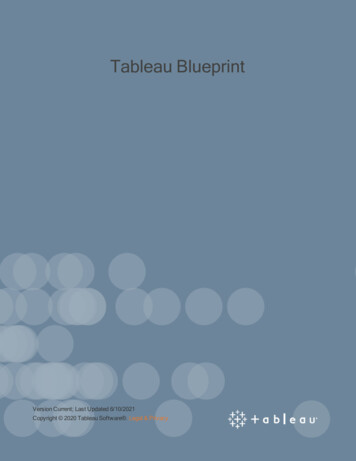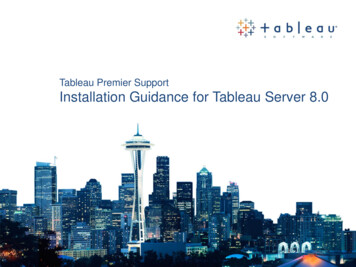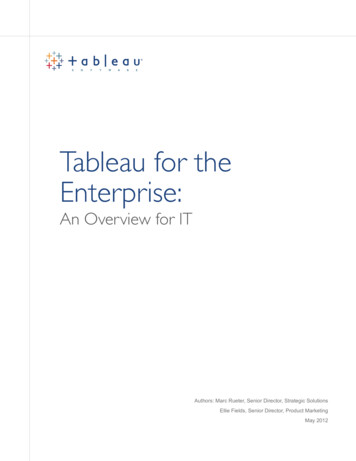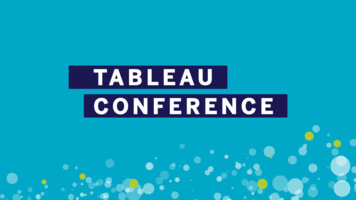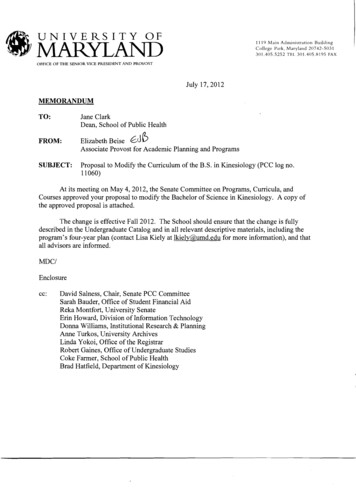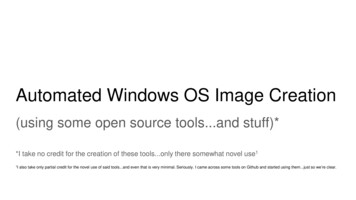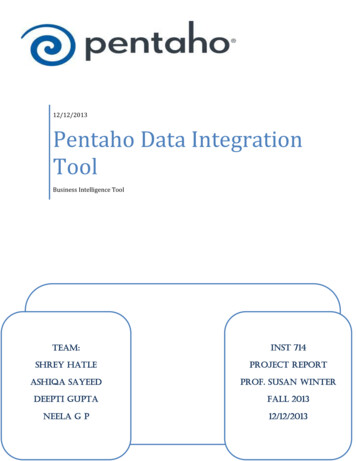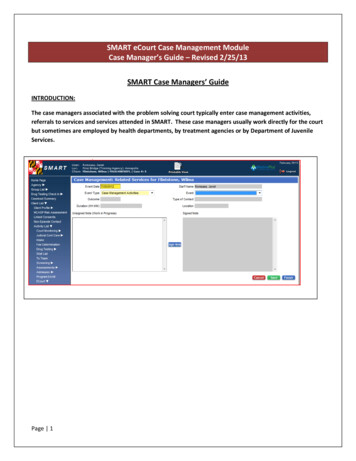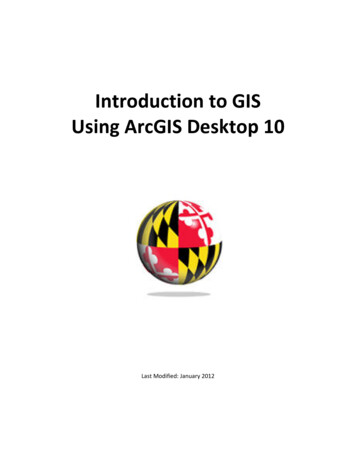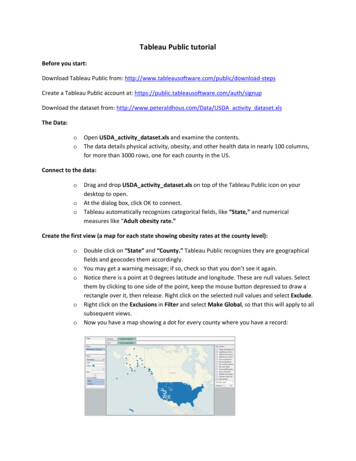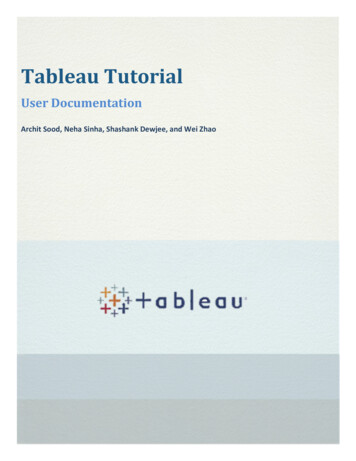
Transcription
Tableau TutorialUser DocumentationArchit Sood, Neha Sinha, Shashank Dewjee, and Wei Zhao
Table of ContentsIntroduction . 2Tableau desktop (Business analytics anyone can use) . 2Tableau server . 3Tableau online . 3Tableau public . 3Why should you use tableau? . 4VizQL . 4Advanced In-Memory Technology- The Data Engine . 4Evaluation of Tableau . 5Strengths . 5Speed . 5Ease of use . 5Beautiful and interactive dashboard . 5Direct connection . 5Easy publishing and sharing . 5Growing market. 5Weakness . 6Not comprehensive solution, specialize in BI. 6No predictive analytical capabilities . 6Customization and Integration with other apps . 6Expandability for analytics . 6Social media integration . 6Robust enterprise-class security. 7Tips . 7FAQs. 7Sample Data Sets . 9Resources . 91
IntroductionIn 2020 the world will generate 50 times the amount of data as in 2011. And 75 times thenumber of information sources (IDC, 2011). Within these data are huge, unparalleledopportunities for human advancement. But to turn opportunities into reality, people need thepower of data at their fingertips. Tableau is building software to deliver exactly that.Tableau Software is an American computer software company headquartered in Seattle, WA,USA. It produces a family of interactive data visualization products focused on businessintelligence.The company was founded at Stanford University’s Department of Computer Science between1997 and 2002. Professor Pat Hanrahan and Ph.D. student Chris Stolte who specialized invisualization techniques for exploring and analyzing relational databases and data cubes ledresearch in the use of table-based displays to browse multidimensional relational databases.Together, they combined a structured query language for databases with a descriptive languagefor rendering graphics and invented a database visualization language called VizQL (VisualQuery Language). VizQL formed the core of the Polaris system, an interface for exploring largemulti-dimensional databases. In 2003, after Stolte recruited his former business partner andfriend, Christian Chabot, to serve as CEO Tableau was spun out of Stanford with an eponymoussoftware application. The product queries relational databases, cubes, cloud database, andspreadsheets and then generates a number of graph types that can be combined intodashboards and shared over a computer network or the internet.In 2010, Tableau reported revenue of 34.2 million dollars. That figure grew to 62.4 million in2011 and 127.7 million in 2012. Profit during the same periods came to 2.7 million, 3.4million, and 1.6 million, respectively. Shares of Tableau Software started trading on the NewYork Stock Exchange after an initial public offering on May 17, 2013The different products which tableau has built are:Tableau desktop (Business analytics anyone can use)Tableau Desktop is based on breakthrough technology from Stanford University that lets youdrag & drop to analyze data. You can connect to data in a few clicks, then visualize and createinteractive dashboards with a few more.We’ve done years of research to build a system that supports people’s natural ability to thinkvisually. Shift fluidly between views, following your natural train of thought. You’re not stuck inwizards or bogged down writing scripts. You just create beautiful, rich data visualizations.2
It's so easy to use that any Excel user can learn it. Get more results for less effort. And it’s 10 –100x faster than existing solutionsTableau serverTableau Server is a business intelligence application that provides browser-based analyticsanyone can use. It’s a rapid-fire alternative to the slow pace of traditional business intelligencesoftware.What makes Tableau different? It's designed for everyone. There's no scripting required, soanyone can become an analytics expert. You can grow your deployment, as you need it. Trainonline for free. Find answers in minutes, not months.Tableau onlineTableau Online is a hosted version of Tableau Server. It makes rapid-fire business analyticseasier than ever. Share dashboards with your whole company and with customers andpartners— in minutes. Provide live, interactive views of data that let people answer their ownquestions, right in a web browser or on a tablet. And do it in a secure, hosted environment.Tableau Online can scale up as much as you need and you can use it wherever you need it. Youdon't need to purchase, set up or manage any infrastructure.Tableau publicTableau Public is for anyone who wants to tell stories with interactive data on the web. It'sdelivered as a service that allows you to be up and running overnight. With Tableau Public youcan create amazing interactive visuals and publish them quickly, without the help ofprogrammers or IT.The Premium version of Tableau Public is for organizations that want to enhance their websiteswith interactive data visualizations. There are higher limits on the size of data you can workwith. And among other premium features, you can keep your underlying data hidden.Why tell stories with data? Because interactive content drives more page views and longerdwell time. Industry experts have cited figures showing that the average reading time of a webpage with an interactive visual is 4, 5 or 6 times that of a static web page.3
Why should you use tableau?There are many reasons why one should use tableau they areIt is very easy to use:You don’t need to know programming of any sort, all you need is some data and tableau tocreate reports that are visually enchanting and which tells a story which you need to tell urmanagers or impress your professor in class.With its revolutionary drag and drop feature u can easily create stories or reports using justyour mouse and a little imagination. All this is possible due to the revolutionary VizQL a visualquery languageVizQLVizQL is a visual query language that translates drag-and-drop actions into data queries andthen expresses that data visually. VizQL delivers dramatic gains in people’s ability to see andunderstand data by abstracting the underlying complexities of query and analysis. The result isan intuitive user experience that lets people answer questions as fast as they can think of them.We believe that VizQL represents a foundational advancement in the area of data analysis andvisualization.Jim Gray, a Turing Award winner and a legendary figure in the field of databases, wrote aboutVizQL in a research highlight: “If you have ever been frustrated when trying to plot a usefulgraph from a simple spreadsheet, you would appreciate the value of a system that allows usersto create stunning graphs interactively and easily from large multidimensional datasets.The fundamental innovation is a patented query language that translates your actions into adatabase query and then expresses the response graphically. Because of VizQL, fast analyticsand visualization are reality. People with little or no training can see and understand data fasterthan ever and in ways like never before. And that’s the biggest difference of all.Advanced In-Memory Technology- The Data EngineMost of the data analytic software have a lot of fancy features but almost all of them fail whenit comes to operating with large amounts of data, this is where the advanced in memorytechnology of tableau is a savior to all of those who need to get reports from ever increasingdata.The tableau data engine is a breakthrough in-memory analytics database designed to overcomethe limitations of existing databases and data silos. Capable of being run on ordinarycomputers, it leverages the complete memory hierarchy from disk to L1 cache. It shifts the4
curve between big data and fast analysis. And it puts that power into the hands of everyone.Ad-hoc analysis of massive data takes place in seconds. No fixed data model is required.To know more about these unique and advanced features of tableau which separates it from itsrivals please go thru this link: Evaluation of TableauStrengthsSpeedThe greatest strength of Tableau is its speed with which it analyzes hundreds of millions of rowsand gives the required answers in seconds. This quality comes in very handy when fast businessdecisions need to be taken.Ease of useAnother strength of Tableau is that it is very easy to use. It’s just basic drag and drop. One canstart using Tableau even with no prior programming experience. With just basic MS Excel skillsone can easily learn Tableau.Beautiful and interactive dashboardThe Dashboard of Tableau is very interactive and gives dynamic results. Rich visualizations canbe created very easily. The graphics and charts are smart and beautiful. Images, web pages anddocuments can be added into the dashboard for easy story telling. All this leads to a muchinsight into the data.Direct connectionTableau allows the users to directly connect to databases, cubes, and data warehouses etc. Thedata access is so easy without any advanced setup and the data is live that keeps gettingupdated on its own. One can pick tables from spreadsheets to data from Hadoop to create aperfect mash-up and get desired results in no time. This is simple ad hoc business analytics.Easy publishing and sharingAfter analyzing the data, the results can be shared live with just a few clicks. The dashboard canbe published to share it live on web and mobile devices.Growing marketTableau is relatively new in the Business Intelligence market but its market share is growing ona daily basis. It is being nearly all industries, from transportation to healthcare. It has big client5
base, which consists of big companies like Microsoft, Nokia, PwC and Deloitte. They use Tableauon a daily basis to meet their business Intelligence requirements.WeaknessNot comprehensive solution, specialize in BITableau Software is an easy to use BI application, but still not a platform for developing analyticapplications that can be broadly shared. It is not designed for enterprise wide deploymentsthat have broad business and technical user populations.No predictive analytical capabilitiesTableau Software allows users to only analyze what has happened. And, Tableau Software doesnot have any statistical or predictive capabilities (they do not support SAS, S , R, ect. likeSpotfire does). Therefore users cannot model or project the best cross-selling or upsellingopportunities. In fact Tableau Software is statistically “challenged” and is extremely limited;providing users with less statistic functions than Microsoft Excel.Customization and Integration with other appsDue to its not open-source based nature and market commodity, Tableau Software cannot becustomized or integrated with other applications (such as Salesforce.com
Tableau Software is an easy to use BI application, but still not a platform for developing analytic applications that can be broadly shared. It is not designed for enterprise wide deployments that have broad business and technical user populations. No predictive analytical capabilities Tableau Software allows users to only analyze what has happened. And, Tableau Software does not have any .File Size: 778KBPage Count: 10
